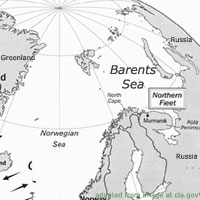Ice extent in Barents Sea less than half of average
Business New Europe - bne.com - 3.19.12 - JRL 2012-51
With air temperatures from 4 to 8 degrees above average, the ice extent in the Barents Sea in February reached the lowest level recorded since satellite surveillance started, writes Barents Observer.
 On average, the Barents Sea has 865,000 square kilometers of ice for the month of February. This year there were only 401,000 square kilometers of ice in that region, the lowest recorded in the satellite data record, the National Snow & Ice Data Center writes.
On average, the Barents Sea has 865,000 square kilometers of ice for the month of February. This year there were only 401,000 square kilometers of ice in that region, the lowest recorded in the satellite data record, the National Snow & Ice Data Center writes.
Sea ice extent in late winter can go up and down very quickly, getting pushed together or dispersed by strong winds. Ice extent usually reaches its annual maximum sometime in late February or March, but the exact date varies widely from year to year.
Also further to the East in the Arctic ice conditions are very unusual this year. The Kara Sea to the East of Novaya Zemlya was completely ice-free in February, as BarentsObserver reported.
A recent NASA-study shows that the oldest and thickest Arctic sea ice is disappearing at a faster rate than the younger and thinner ice at the edges of the Arctic Oceans floating ice cap. The shows that multi-year ice has diminished with each passing winter over the last three decades with a rate of -15.1 percent per decade.
Keywords: Russia, Environment - Russian News - Russia
With air temperatures from 4 to 8 degrees above average, the ice extent in the Barents Sea in February reached the lowest level recorded since satellite surveillance started, writes Barents Observer.

file photoOn average, the Barents Sea has 865,000 square kilometers of ice for the month of February. This year there were only 401,000 square kilometers of ice in that region, the lowest recorded in the satellite data record, the National Snow & Ice Data Center writes.
Sea ice extent in late winter can go up and down very quickly, getting pushed together or dispersed by strong winds. Ice extent usually reaches its annual maximum sometime in late February or March, but the exact date varies widely from year to year.
Also further to the East in the Arctic ice conditions are very unusual this year. The Kara Sea to the East of Novaya Zemlya was completely ice-free in February, as BarentsObserver reported.
A recent NASA-study shows that the oldest and thickest Arctic sea ice is disappearing at a faster rate than the younger and thinner ice at the edges of the Arctic Oceans floating ice cap. The shows that multi-year ice has diminished with each passing winter over the last three decades with a rate of -15.1 percent per decade.